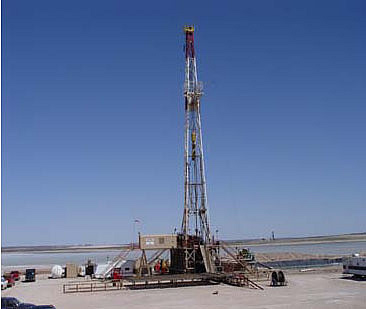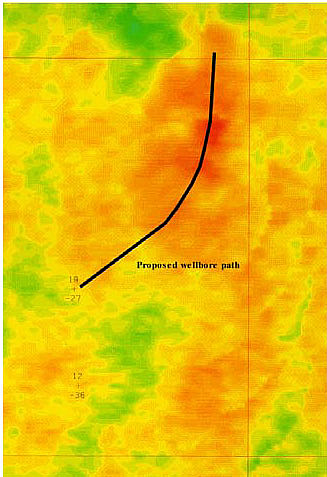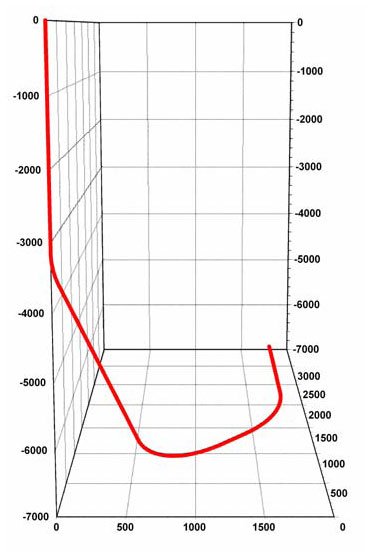The Nash Draw field in Eddy County, NM, produces oil and associated gas from the Permian (Guadalupian age) Brushy Canyon Formation. The Brushy Canyon is a relatively new producer in the Delaware Basin of West Texas and New Mexico.
Many of the recent discoveries in the Brushy Canyon were in wells originally drilled to deeper zones, particularly the Morrow Sandstone (Lower Pennsylvanian) in search of gas. These wells were completed in the Upper Pennsylvanian and Lower Permian only when the deeper zones proved unproductive or when these zones were abandoned after production declined to uneconomic rates. There is generally little attempt to fully develop the upper pay zones, and the full potential of many of these fields remains to be proven. Regionally, the fine-grained sandstones of the Brushy Canyon contain as much as 400-800 million barrels of original-oil-in-place (OOIP), and thus this formation represents a significant reservoir interval in the Permian Basin. However, low permeability and petrophysical heterogeneity limit primary recovery to as little as 10-15% of OOIP.
Low recovery in the Nash Draw Unit (NDU) reservoir is caused by low reservoir energy, less-than-optimum permeabilities and porosities, inadequate reservoir characterization, and poor past reservoir-management strategies. Based on the production constraints due to high gas-oil ratios that have been observed in other, similar Delaware fields, pressure maintenance in continuous parts of the reservoir is a likely requirement at NDU.
Three basic constraints to producing the Nash Draw Unit Brushy Canyon Reservoir are 1) limited areal and interwell geologic knowledge, 2) lack of an engineering tool to evaluate the various producing strategies, and 3) limited surface access that will prohibit development with conventional drilling. The limited surface access at NDU is caused by the proximity of underground potash mining and surface playa lakes.
Project Results
The project has used advanced technologies, including reservoir characterization, reservoir simulation, 3-D seismic, advanced log analysis, and horizontal drilling to identify and develop previously unattainable reservoirs. 3-D seismic has identified potential reservoir targets underlying potash mines. Horizontal drilling was used to drill through multiple seismic anomalies and access reserves that would not be developed using vertical wells. To date, three directional/horizontal wells have been drilled at the Nash Draw project. These three wells have developed recoverable revenues of 1,000,000 barrels of oil and 5 billion cubic feet of natural gas.
Benefits
The ability to image, predict, and reach reserves that are restricted via typical vertical development are significant and vital to the energy need of the United States. There are 500,000 acres of federally owned land comprising the potash area in southeastern New Mexico. In excess of 1 billion barrels of oil equivalent (BOE) reserves are believed to lie beneath this area. Vertical development is restricted due to mines and potential potash reserves. By employing drilling islands and deviated/horizontal drilling, much of these reserves can be accessed.
Project Summary
The use of advanced geophysical log analysis techniques developed from the Nash Draw project have proven useful in defining additional productive zones and refining completion techniques. The advanced geophysical log analysis program proved to be especially helpful in locating and evaluating potential recompletion intervals, which has resulted in low development costs with only small incremental increases in lifting costs.
To develop additional reserves at lower costs, zones behind pipe in existing wells were evaluated using techniques developed for the Brushy Canyon sandstones. Geophysical log analysis techniques developed in Phase I of the project were used to complete a total of 13 producing intervals of the Nash Draw wells in shallower zones. Four wells were recompleted in 1999, which allowed the development of economic reserves during a period of low crude oil prices. An additional four wells were recompleted in 2000, which resulted in 123,462 barrels of oil and 453,424 million cubic feet of natural gas reserves being added at a development cost of $1.57 per BOE. Two wells, the Nash Draw #29 and #38, were recompleted in 2001, which added 7,000 barrels of oil and 18,000 million cubic feet of natural gas reserves at a cost of $9.70 per BOE. The Nash Draw wells #1, #12, #15, and #20 were completed in shallower zones during 2002 and 2003, which added 128,000 barrels of oil and 150,000 million cubic feet of natural gas reserves at a cost of $1.62 per BOE. Overall, the weighted average development cost is $1.87 per BOE.
One of the technologies being tested at the Nash Draw project is the Fuzzy Expert Exploration Tool, developed by Dr. Bob Balch and his team at New Mexico Institute of Mining and Technology's Petroleum Recovery Research Center, that was used to predict the expected outcome of the drilling of the Nash Draw #34 well. The expert tool uses regional geology, source rock data, offset wells, and other parameters to predict a project's success.
Six new wells were drilled for data acquisition. Multiple sidewall cores were obtained for analysis. Approximately 203 feet of full core was cut from 6,641 to 6,844 feet in the Nash Draw Unit #23 well. The routine core analysis included porosity, permeability, and saturation for each foot of core. Special core analysis to determine wettability, relative permeabilities, mineralogy, pore structure, and clay content were utilized for characterization. Normal suites of logs were obtained in all wells, and a magnetic resonance tool was run in Nash Draw Unit #23 for comparison with the cores taken. Well data, including logs, cores, fluid properties, and production history and analysis, were distributed to the multidisciplinary geoscience team using the interactive data base. A vertical seismic profile survey was performed in the Nash Draw Unit #25 well, and the data obtained was used to calibrate the 3-D seismic data that was obtained in June 1996.
The 3-D data set has been used to create the geologic model. Reservoir modeling used advanced log analysis data to develop the second-generation model. Seismic amplitudes were used to distribute reservoir attributes in the third-generation reservoir model. The 3-D seismic data have yielded drilling targets, indicated that the proposed pilot area may be compartmentalized, and identified a more continuous area of the reservoir. Two wells were drilled into seismic anomalies, and a directional/horizontal well was drilled to reach a seismic anomaly located beneath a playa lake and potash reserves.
Analysis of production rates versus cumulative production, bottomhole pressure versus gas/oil ratio, and seismic data using geostatistics have helped identify drainage areas and boundaries. Incremental oil production since the beginning of the project is 274,206 barrels of oil, and, if successful, this project will recover an additional 18.5 million barrels of oil, raising the field recovery from 10% to 45% of OOIP. Researchers identified two potential products: an advanced log analysis program and a database management system.






